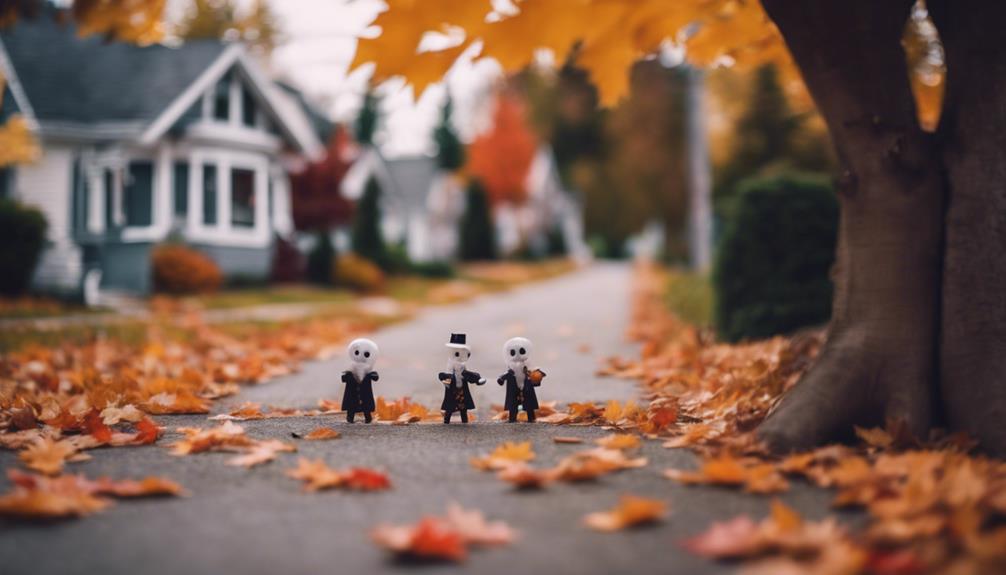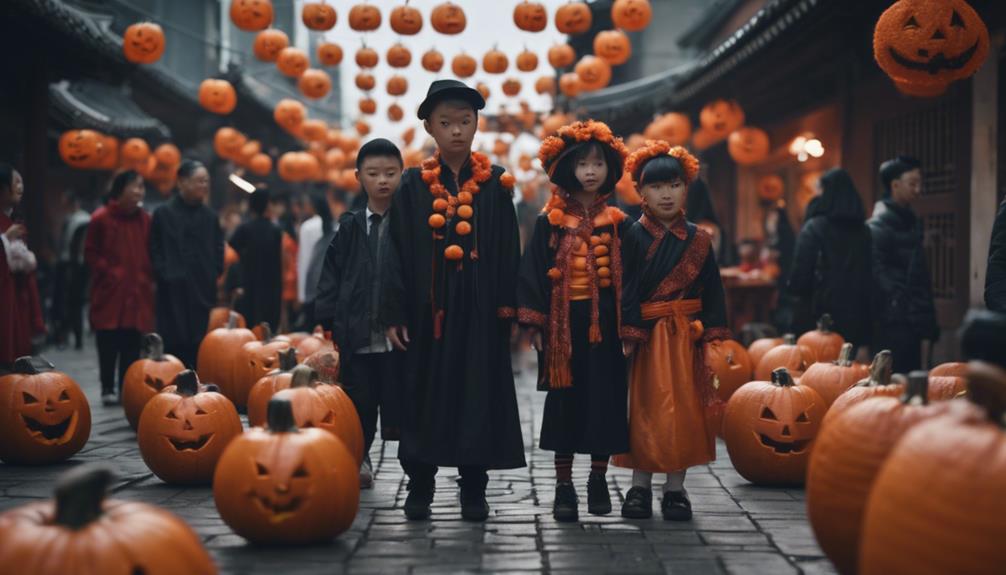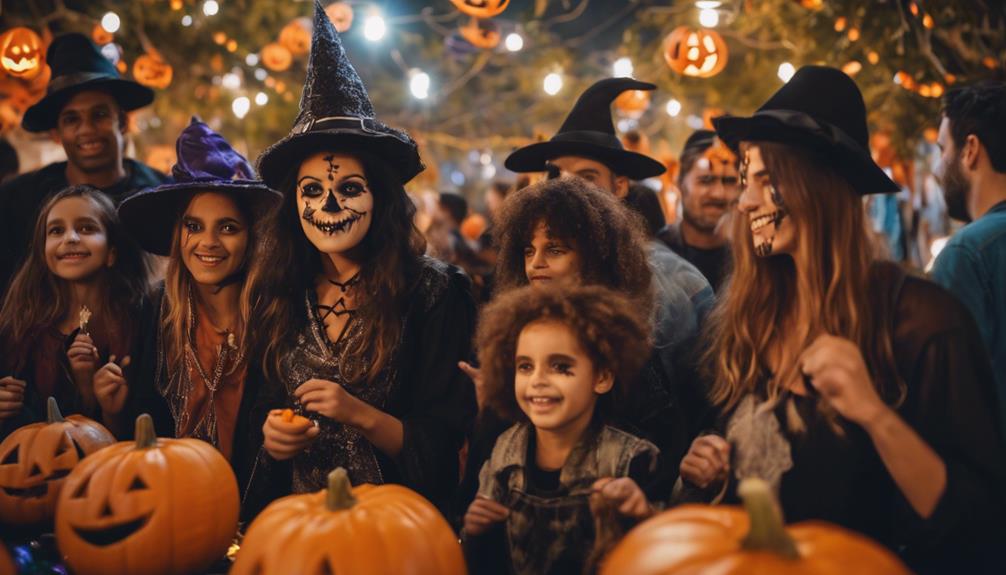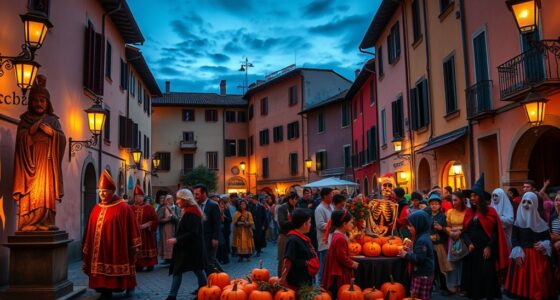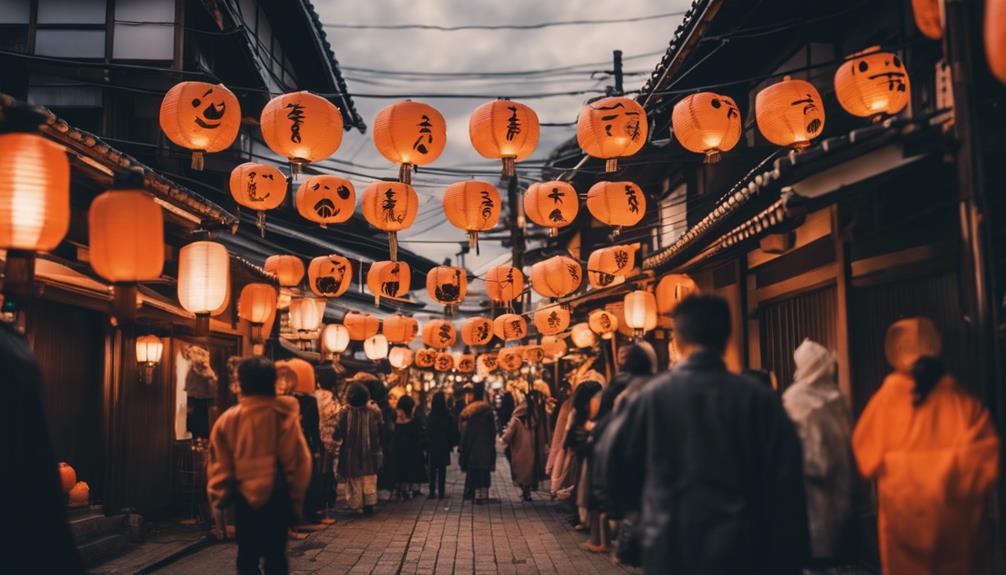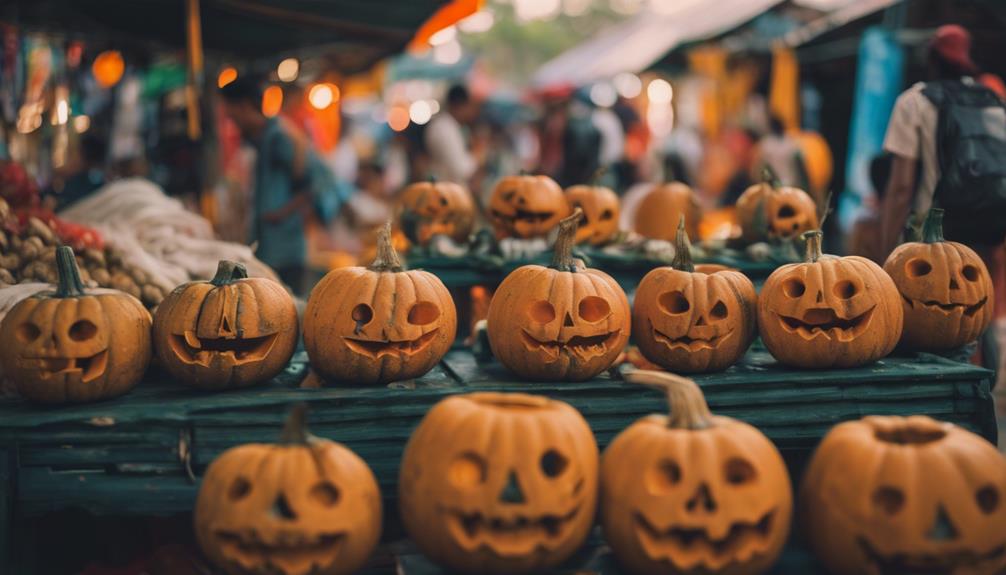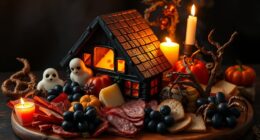In Canada, Halloween traditions hold a significant place in the hearts of many. The history traces back to Irish and Scottish immigrants in the mid-1800s, blending Celtic practices with modern festivities. Canadians partake in carving elaborate pumpkins, adorning their homes, and flaunting creative costumes. Trick-or-treating is a cherished custom, with an emphasis on safety and community engagement. Popular activities include haunted house tours, pumpkin carving contests, and spooky-themed parties. The commercial aspect has made Halloween the second most profitable holiday, influencing consumer behavior. These traditions showcase a unique fusion of old-world charm and contemporary revelry. Discover more about Canadian Halloween customs.
Key Takeaways
- Canadians enthusiastically celebrate Halloween with pumpkin carving, costume contests, and haunted house tours.
- Trick-or-treating is a cherished tradition in Canada, emphasizing community engagement and safety.
- The commercialization of Halloween has made it the second most commercially successful holiday in Canada.
- Canadian Halloween celebrations blend old traditions and new customs, like bobbing for apples and corn mazes.
- Community involvement is strong in Canadian Halloween events, showcasing a tight-knit bond among residents.
History of Halloween in Canada
The history of Halloween in Canada can be traced back to the mid-1800s when Irish and Scottish immigrants brought their Celtic traditions to urban North America. These immigrants celebrated Samhain, a festival marking the end of the harvest season and the beginning of winter. Over time, these ancient customs blended with local practices, giving rise to the modern-day Halloween festivities in Canada.
One significant tradition that emerged from this cultural fusion was the practice of children dressing up in costumes and going door-to-door for treats, known as 'trick or treat.' The first recorded instance of children in disguise was in Vancouver in 1898, and the term 'trick or treat' was first documented in Lethbridge, Alberta, in 1927. By the 1920s, trick or treating had become a widespread practice across Canada.
Today, Halloween in Canada is a commercial holiday that brings communities together, with children excitedly donning costumes and collecting treats. Organizations like Food Allergy Canada also play a role in promoting safe celebrations for children with food allergies, ensuring that everyone can enjoy the Halloween traditions.
Popular Halloween Activities in Canada

Popular Halloween activities in Canada range from haunted house tours in cities like Toronto, Vancouver, and Montreal to festive pumpkin carving competitions and spooky-themed parties. Canadians embrace the Halloween spirit through various activities that bring communities together and create lasting memories.
Here are some popular Halloween activities enjoyed in Canada:
- Haunted House Tours: Canadians flock to cities like Toronto, Vancouver, and Montreal to experience thrilling haunted house tours that offer spine-chilling excitement.
- Pumpkin Patches: Families visit pumpkin farms during the Halloween season to pick the perfect pumpkin for carving and decorating.
- Costume Contests: Many Canadians participate in costume contests, showcasing their creativity and dressing up as their favorite characters.
- Spooky-Themed Parties: From eerie decorations to themed snacks, Canadians host and attend spooky-themed parties to revel in the Halloween festivities.
These activities reflect the enthusiasm Canadians have for Halloween traditions, creating a sense of community and joy during this spooky season.
Trick-or-Treating in Canadian Neighborhoods
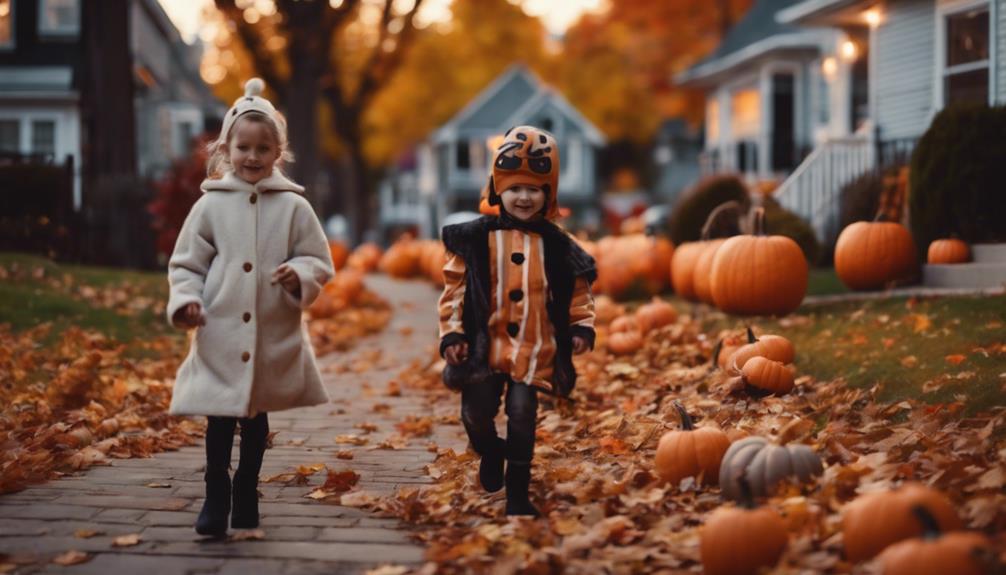
Venture out into Canadian neighborhoods between 5:30 pm and 8:30 pm on October 31 for the time-honored tradition of trick-or-treating.
When participating in trick-or-treating in Canadian neighborhoods, it's crucial to follow specific guidelines for distributing treats. Consideration for allergies, avoiding homemade treats, and purchasing treats in bulk are key aspects to keep in mind.
Guarantee children's safety by planning routes in advance, walking on designated sidewalks, moving in groups, and carrying flashlights for visibility.
Grocery stores across Canada prepare well in advance for Halloween by stocking up on treats to meet the high demand during trick-or-treating hours.
Additionally, Canadians engage in the UNICEF Halloween Walk-a-thon campaign as part of their Halloween celebrations, contributing to raising funds for children globally.
Embrace these practices to make the most of the Halloween spirit while ensuring the safety and enjoyment of all participants in Canadian neighborhoods.
Impact of Commercialization on Halloween

The commercialization of Halloween has greatly impacted the traditions surrounding the holiday in Canada. Consumer behavior has shifted over the years, with a greater emphasis on purchasing costumes, decorations, and treats.
This commercial influence hasn't only changed how Canadians celebrate Halloween but has also led to debates about cultural appropriation and social implications.
Commercial Influence on Halloween
With Halloween in Canada becoming a multi-billion dollar industry, the influence of commercialization on the holiday has sparked various debates and concerns. Here are four key points to ponder:
- Commercial Success: Halloween in Canada ranks as the second most commercially successful holiday, trailing only behind Christmas. This highlights the significant financial impact the holiday has on the Canadian economy.
- Historical Influence: Halloween postcards and greeting cards were popular from 1900 to 1940, playing a pivotal role in the commercialization of the holiday. These early marketing efforts contributed to shaping Halloween traditions in Canada.
- Spending Disparities: Canadians spend more per capita on Halloween compared to Americans, showcasing the substantial commercial impact of the holiday in Canada. This heightened expenditure reflects the increasing commercial influence surrounding Halloween celebrations.
- Controversies: The commercialization of Halloween hasn't been without its controversies, with concerns raised about the sexualization of young girls and the perpetuation of stereotypes through certain Halloween costumes. These debates underscore the complex interplay between commercial interests and cultural sensitivities during Halloween festivities.
Consumer Behavior Changes
As commercialization continues to shape Halloween traditions in Canada, consumer behavior changes have become increasingly pronounced, reflecting a significant shift in spending patterns and cultural influences.
The Halloween industry in Canada has burgeoned into a $1-billion enterprise by 2014, ranking it as the country's second most commercially successful holiday. Canadians now outspend Americans per capita on Halloween, showcasing a notable alteration in consumer behavior.
The influence of commercialization on Halloween can be traced back to the early 20th century when Halloween postcards and greeting cards gained popularity, marking the initial stages of commercial involvement. However, this commercial impact hasn't been without controversy, with criticisms emerging regarding costumes that sexualize young girls and perpetuate stereotypes.
In present times, Canadians allocate around C$356 million to candy purchases in October alone, exceeding the average monthly spending by C$80 million, underscoring the substantial consumer behavior changes during the Halloween season.
Cultural Significance of Halloween in Canada
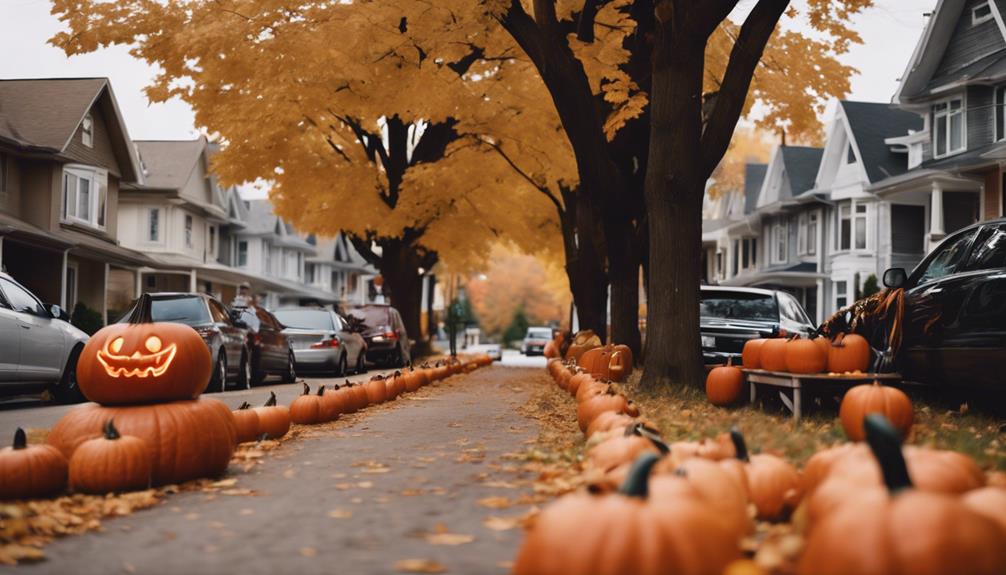
Halloween holds significant cultural importance in Canada due to its roots dating back to Irish and Scottish immigrants in the 1800s. Canadians enthusiastically partake in Halloween traditions by adorning their homes with festive decorations, carving intricate pumpkins, and donning creative costumes.
Trick-or-treating customs on October 31st are widely observed in Canada, emphasizing safety precautions and fostering community engagement.
Canadian Halloween Traditions
In Canada, Halloween traditions have deep cultural roots stemming from Celtic and Christian customs that were introduced by Irish and Scottish immigrants in the 1800s. The celebration of Halloween in Canada has evolved over time, incorporating a mix of traditional elements and modern practices to create a unique blend of festivities.
- Trick or Treat: The popular tradition of 'trick or treat' was first recorded in Canada in 1927, highlighting the early adoption of Halloween customs in the country.
- Pumpkin Carving: Canadians engage in pumpkin carving activities, creating intricate designs on pumpkins to display during the Halloween season.
- Dressing up in Costumes: People of all ages in Canada participate in dressing up in costumes, ranging from spooky characters to beloved superheroes.
- Trick-or-Treating: Children go door to door in neighborhoods, collecting candies and treats, embodying the spirit of Halloween and community engagement.
Halloween has become a significant cultural celebration in Canada, with diverse traditions and activities embraced by the populace, making it a cherished holiday nationwide.
Festive Decorations in Canada
In addition, embracing festive decorations plays a pivotal role in highlighting the cultural significance of Halloween in Canada. Canadians take pride in adorning their homes with spooky themes such as ghosts, witches, and skeletons, reflecting the essence of this holiday. The traditional colors of orange and black dominate the decor landscape, accompanied by motifs like cobwebs, bats, and spiders, all contributing to the eerie ambiance.
Pumpkins hold a special place in Canadian Halloween traditions, not just for display but also for intricate carving into Jack-o-lanterns, adding a touch of artistry to the decorations. DIY crafts like paper bat garlands and spider web wreaths are popular choices for those seeking a personalized touch to their Halloween decor.
Additionally, with affordable items readily available at dollar stores, Canadians can easily procure the necessary supplies to create a festive atmosphere in their homes, embracing the spirit of Halloween with creativity and flair.
Trick-Or-Treating Customs in Canada
With trick-or-treating being a cherished tradition in Canada, the evening of October 31 brings a flurry of activity as neighborhoods come alive with costumed children enthusiastically searching for treats.
Here are some insights into the trick-or-treating customs in Canada:
- Timing and Tradition: Trick-or-treating in Canada typically occurs on October 31 between 5:30 pm and 8:30 pm, following the North American tradition.
- Safety and Considerations: Canadians follow guidelines for giving out treats, including considerations for allergies, avoiding homemade treats, and buying treats in bulk to accommodate the large number of trick-or-treaters.
- Child Safety Tips: Safety tips for children during trick-or-treating include planning routes, walking on sidewalks, going in groups, and carrying flashlights to enhance visibility.
- Charitable Aspect: Canadians participate in the UNICEF Halloween Walk-a-thon campaign to raise funds for children globally, showcasing a charitable aspect of Halloween celebrations in the country.
These customs highlight the importance of safety, community spirit, and giving back during this festive occasion.
Evolution of Halloween Celebrations in Canada
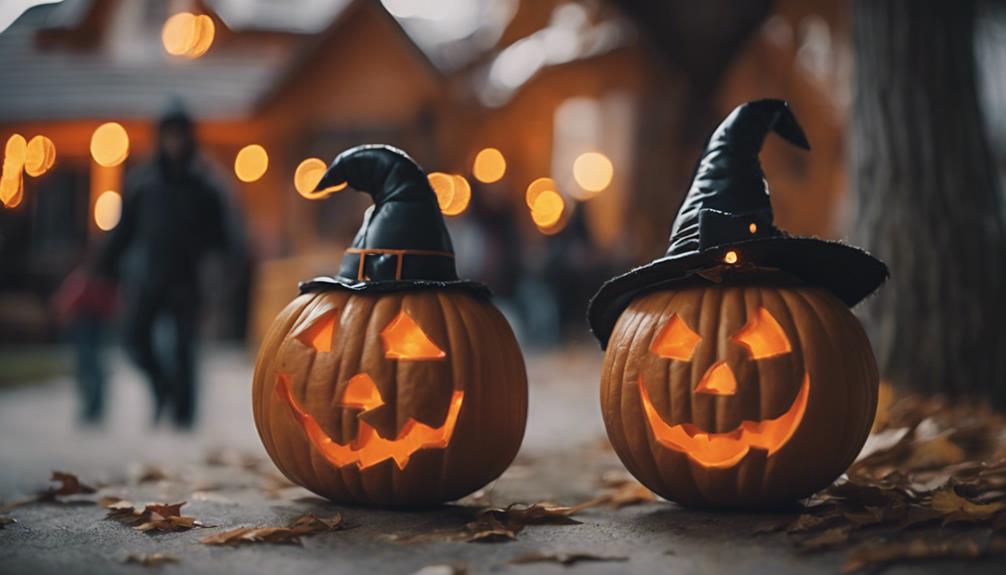
The evolution of Halloween celebrations in Canada reflects the rich tapestry of traditions brought by its diverse immigrant populations. Irish and Scottish immigrants introduced Halloween celebrations to Canada in the mid-1800s. The first recorded instance of children dressing in disguise for Halloween was in Vancouver in 1898, showcasing the early adoption of this tradition in Canadian cities.
The term 'trick or treat' was first documented in Lethbridge, Alberta, in 1927, further solidifying the evolution of Halloween customs in the country. Trick or treating, which originated in Britain in the late 18th century, became a common practice in Canada by the 1920s, illustrating how this tradition has seamlessly integrated into Canadian culture over the years.
As Halloween celebrations continue to evolve, they remain a prominent part of Canadian festivities, blending the old traditions brought by immigrants with new customs that have emerged over time.
Unique Canadian Halloween Traditions
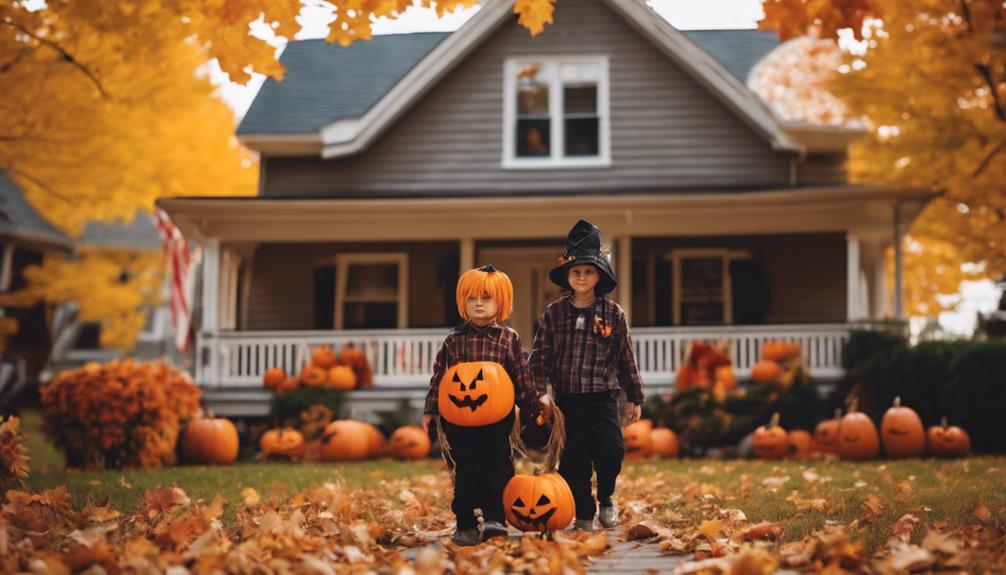
Exploring the rich tapestry of Halloween traditions in Canada reveals unique customs that have evolved over time, showcasing a blend of old and new practices embraced by Canadians nationwide. These traditions reflect a deep-rooted connection to the spirit of Halloween while incorporating modern elements for a diverse celebration.
Here are some unique Canadian Halloween traditions:
- Pumpkin-Carving Contests: Canadians engage in friendly competitions to showcase their creativity in carving intricate designs on pumpkins, adding a festive touch to the season.
- Haunted Houses and Corn Mazes: Visitors can immerse themselves in spooky experiences at haunted houses or challenge themselves in intricate corn mazes, adding an element of thrill to the celebrations.
- Trick-or-Treating: Originating in Canada in the 1920s, trick-or-treating remains a beloved tradition where children dress up in costumes and go door-to-door for treats, fostering community spirit.
- Bobbing for Apples: A traditional Halloween game, bobbing for apples adds a nostalgic touch to the festivities, reminding Canadians of simpler times while honoring age-old customs.
Community Involvement in Canadian Halloween Events
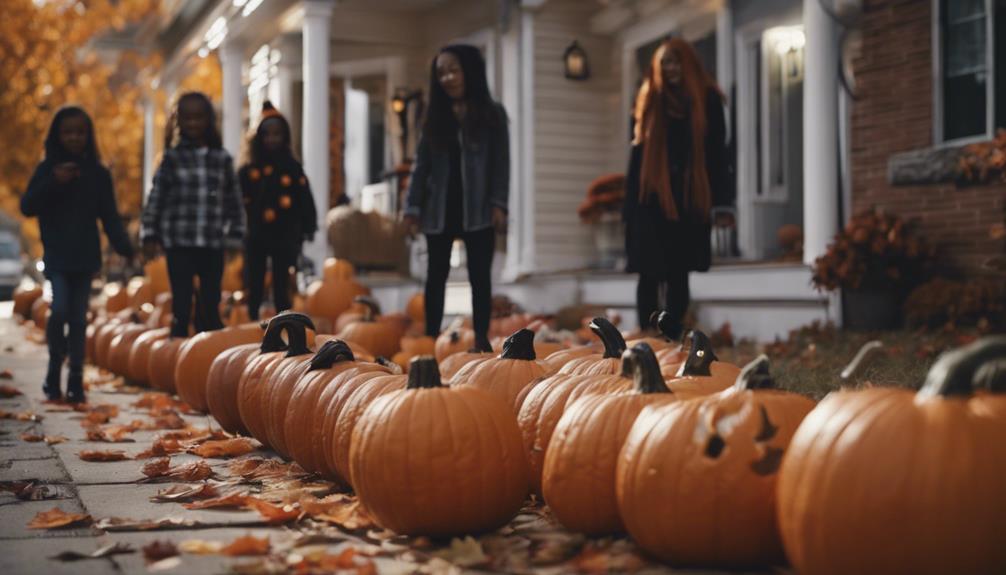
As you explore Halloween traditions in Canada, you'll notice a strong emphasis on community involvement in organizing and participating in events. Canadian communities come together to celebrate Halloween, with local businesses, schools, and organizations collaborating to host a variety of Halloween events. From haunted houses to pumpkin carving contests and costume parades, there's a wide range of activities that promote a sense of community spirit and unity among residents.
Volunteers and sponsors play vital roles in the success of these Halloween events, dedicating their time and resources to make sure that the celebrations run smoothly. The support from volunteers and sponsors highlights the strong community bond that's fostered during Halloween in Canada.
Frequently Asked Questions
Do Canadian People Celebrate Halloween?
You celebrate Halloween in Canada, a widely embraced tradition. The holiday isn't a public holiday but is enjoyed by people of all ages.
Carving pumpkins, dressing up, and trick-or-treating are common. Unique events like haunted walks and charity campaigns occur. Safety is a priority with guidelines for trick-or-treating.
Canadians make sure children follow safety measures. Halloween thrives in Canada with diverse celebrations and a focus on safety for all.
Do People Go Trick-Or-Treating in Canada?
In Canada, trick-or-treating is a cherished Halloween tradition where kids roam neighborhoods, seeking treats. This festive activity usually occurs on October 31 from 5:30 pm to 8:30 pm. Canadians often prepare by purchasing goodies ahead of time.
Safety is key, with tips like planning routes, going in groups, and inspecting treats. Some communities even partake in the UNICEF Halloween Walk-a-thon to support children globally.
Do People in Canada Dress up for Halloween?
Yes, people in Canada dress up for Halloween. It's a widely embraced tradition across the country. Canadians of all ages don costumes, from scary to fantastical, for school, work, and trick-or-treating on October 31.
Elaborate and creative outfits are crafted to embody various characters and concepts, fostering a festive spirit during this spooky season. Dressing up plays a significant role in the Halloween celebrations enjoyed by many in Canada.
How Does Halloween Work in Canada?
In Canada, Halloween typically involves carving pumpkins, dressing up in costumes, and trick-or-treating. The trick-or-treating hours usually fall between 5:30 pm and 8:30 pm on October 31, with a focus on safety protocols.
Canadians also engage in initiatives like the UNICEF Halloween Walk-a-thon to support children globally. While Halloween isn't a public holiday in Canada, it remains widely embraced as a festive occasion that promotes community safety and enjoyable traditions.
Conclusion
To sum up, while Canadians may seem to embrace Halloween traditions with enthusiasm, it's worth noting that the commercialization of the holiday has greatly altered its cultural significance.
As neighborhoods become increasingly focused on elaborate decorations and extravagant costumes, one can't help but wonder if the true spirit of Halloween, rooted in community and tradition, has been overshadowed by consumerism.
So next time you see a giant inflatable pumpkin on your neighbor's lawn, remember, Halloween in Canada may not be all about tricks and treats after all.
